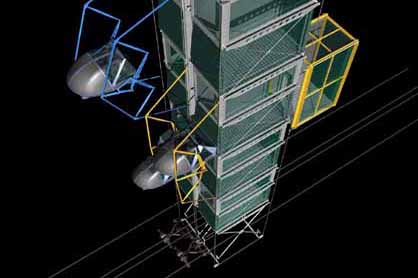|
|
||||||
| image | activities | contacts | links | italiano | ||||||
|
5th
International Festival for Architecture in Video |
||||||
|
introduction program - dates - authors - works - exhibitions partners credits previous editions mailto |
 Takehiko Nagakura The Drive-in House (1968) - adopted from the project of Michael Webb Massachusetts Institute of Technology USA 1999, 2’12” In the 1960's, Michael Webb, a young British architect, explored the future of our living environment. His Drive-in House project envisioned an integration of habitation and transportation. This film attempts to illustrate the transforming mechanics, the sense of speed, and the experiential nature of his machine. According to the original description by Webb, the system consists of specially designed vehicles running on tracks and high-rise building structures with mechanical cranes. As a vehicle approaches a building, a crane picks up the vehicle, elevates it along the side of the building, and finally plugs it into an apartment. The entire process takes place while the driver is inside the vehicle. To accurately depict the mechanical transformation process, inverse kinematics techniques were used to compute the positions of the transforming components, which are interconnected through pins, rollers and pistons. To simultaneously understand the elegance of the mechanical movements and the experience of the driver, multiple cameras were placed inside and outside the vehicle to give variations in viewpoint. Takehiko Nagakura is an architect from Tokyo. At MIT, he teaches courses related to computer-aided design, and his research focuses on the representation and computation of architectural space and formal design knowledge. He has founded and led the Architecture, Representation and Computation group (ARC) since 1996. His recently finished building, Gushikawa Orchid Center in Okinawa, Japan has been awarded the SD Review Award (1998) and Nikkei Kyushyu District New Office Award (1999). He leads the project Unbuilt Monuments, in which his team is developing computer graphics visualization of significant but unrealized early modern architecture such as the Danteum (Terragni and Lingeri, 1938) and the Monuments for the Third International (Tatlin, 1919). Its recent video productions have been exhibited in Tokyo, Osaka, Orlando, Los Angeles, San Francisco, Charlottesville, Paris, Milan and Florence in film festivals and computer graphics conferences such as SIGGRAPH Animation Theaters of 1998 and 1999. For the film production of Le Corbusier's Palace of Soviets (collaboration with Shinsuke Baba), his team was awarded with the Third Prize of Prix Pixel-INA Science Division at 19th Edition of Imagina in Monaco. Inspired by the perspective apparatus Albrecht Durer documented in 1525, he invented DIGITARAMA, a computer based space-form projection machine, developed for the Virtual Architecture Show at Tokyo University Digital Museum in June 1997. Nagakura's PhD dissertation (1996) at Harvard University proposed a computable paradigm for representing architectural shapes and transformations. Before coming to MIT in 1993, Nagakura worked for Fumihiko Maki in Tokyo, and was an instructor at Harvard University, Graduate School of Design. He earned Bachelor of Engineering in Architecture from Tokyo University in 1985, Master of Architecture from Harvard University in 1987, Master of Engineering in Architecture from Tokyo University in 1988, and completed his PhD at Harvard in 1996. In 1985 he received the prestigious Ishizaka Memorial Foundation scholarship from the Japanese Federation of Economic Institutions. He is the recipient of the Japan Information Culture Society Grand Prize in 1999. |
VIDEO | ||||